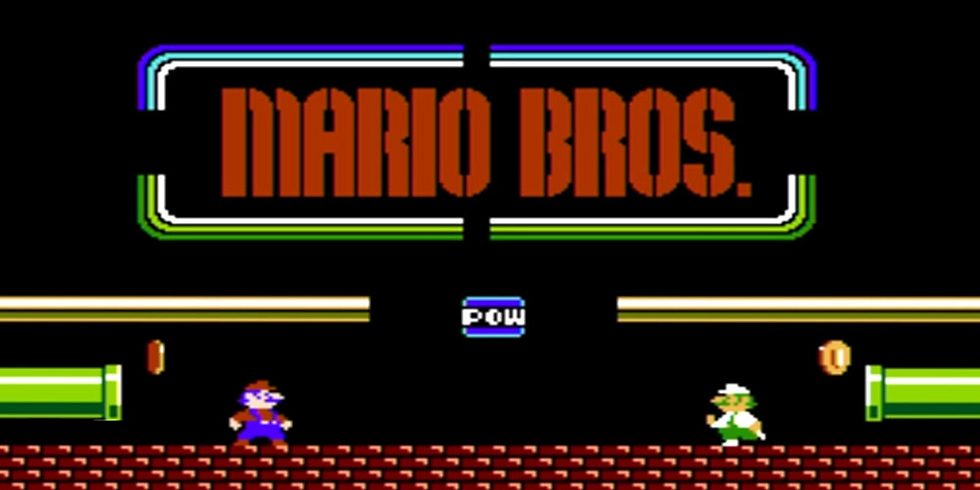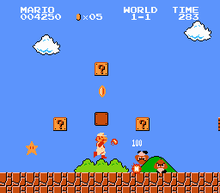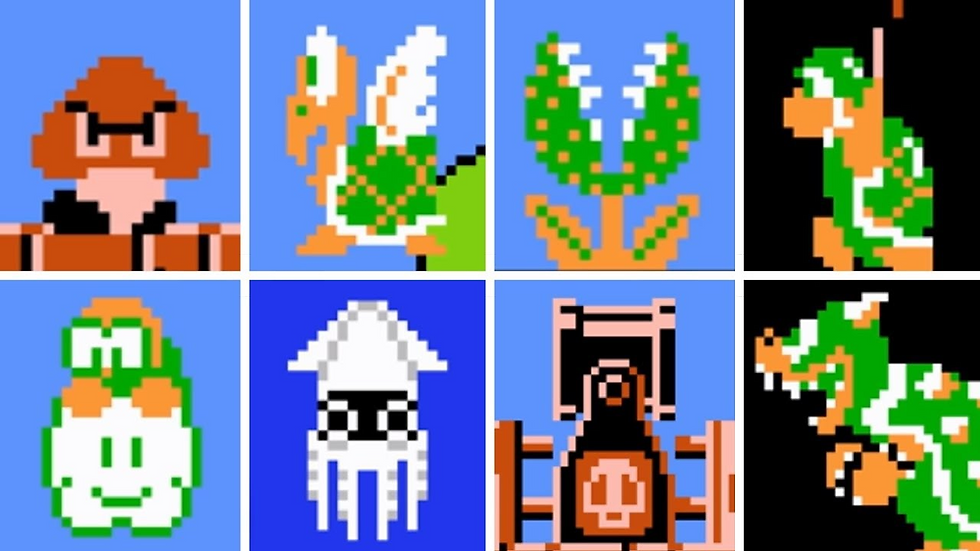Super Mario Bros (1985) for the Nintendo Entertainment System
- Sam Cawley
- Aug 18, 2021
- 6 min read
Updated: Aug 31, 2021
This time around we're looking at one of the most recognisible games in history, that launched Nintendo's golden child into the mainstream and solidified Nintendo's place in the industry, it's Super Mario Bros for the NES.

History
Back when Nintendo was still new to the video game market, they were trying their best to innovate where they could.
Gaming was still fresh with arcades and home console gaming was questionable at best with Atari and Intellevision sort of letting you play games in your home, but their games certainly required some imagination. Basically they were for simple fun with not a lot to them.

However when Nintendo threw their hat into the ring with the Nintendo Entertainment System (NES), they wanted to stand out and offer players a wide range of titles that could entertain for hours while being mini adventures or simple arcade style fun.
In terms of the Mario character, this wasn't his first appearance by any means. He'd actually appeared in the arcade game simply titled Mario Bros, alongside his brother Luigi and he was also in the arcade game Donkey Kong, albeit under the different name of Jumpman.

For Super Mario Bros, the games designers Shigeru Miyamoto and Takashi Tezuka wanted a more "athletic" game and chose a side scrolling platformer.
The name Super Mario Bros actually comes from the Super Mushroom power up found in the game, and it's function of making Mario bigger comes from Japanese folklore which depicts people wandering off in the woods to search for and way Magical Mushrooms. This is also where the setting of the Mushroom Kingdom came from, as well as Princess Toadstool, who Mario is trying to save.
Mario's first level World 1-1 was also designed to be a tutorial level that explained everything the player would need to know to beat it, as tutorials in games were pretty much unheard of at the time.

Overall the game was a success, launching alongside the NES and bundled into the package with Duck Hunt too and it has seen nearly countless re-releases.
Story
Story wasn't really something you'd see in many games back in the 80s, often being included in game manuals rather than the game itself, with Super Mario Bros being no exception.
According to the manual, the Mushroom Kingdom and all its inhabitants were attacked by King Koopa (Bowser) and were turned into bricks. To make matters worse, Princess Toadstool was kidnapped and is the only one who can undo Koopas curse. It's upto Mario to save the princess and restore peace and defeat King Koopa.
Simple plot but for the time it didn't need to be anything more, so with that let's take a look at how it plays.
Gameplay
If Miyamoto and Tezuka wanted Super Mario Bros to have a more "athletic" feel, they absolutely succeeded. Levels are essentially obstacle courses which you need to navigate through by jumping over stuff, stomping on enemies, or ignore them completely, picking up power ups to make life easier, all before reaching a flag pole at the end and completing the level.
I'd describe the way Mario is controlled as easy to learn, difficult to master. There's a certain weight and momentum to him where careful timing and quick reflexes make level completion tricky at times, especially towards the end of the game. Running at top speed can let you bound through a level at the cost of manoeuvrability and difficulty coming to a stop if you need to. Platforming feels great though and it's well balanced where any deaths don't feel unfair and allow the player to learn the layout before re-attempting, when they feel more prepared.
Level and enemy design is something I particularly enjoy as the increasing difficulty as you progress feels gradual. For instance, level 1-1 features Goombas and regular Koopas, basic enemies that walk in a straight line. They're easy enough to defeat or ignore entirely if you're not confident with jumping on them accurately. Compared to a later enemy, the Hammer Bro, the difficulty ramps up but still feels fair. Hammer Bros throw constant hammers at the player which small windows in between throws that a player can pass through unharmed if their quick. Patience is the best way to beat them and defeating them feels like a victory and is very rewarding.

Levels are sometimes themed around these enemies too, for example the Lakitu enemy only appears in certain levels. Lakitus hover at the top of the screen and throw spiny shell enemies that can't be defeated with jumps. The levels they appear in tend to have either long flat surfaces which let you outrun them before they throw anything in front of you, or feature taller structures that give you chance to jump to them and take them out temporarily.
There are around four levels in a "World" with eight worlds overall. Each world concludes with a castle level, by far the most hazardous type in the game. Upon reaching the end of one of these castle stages you come face to face with King Koopa himself, who you need to get past to hit a switch that drops him into a pit and finishing the world. I love these final stages as in every one Koopa has something new to use against you, going from simple fire blasts in the first encounter to fire and hammers in later ones. Complete all eight worlds and defeat Koopa one last time and you've finished the game, which unlocks a new, harder version to play all over again.

In order to help the player on their adventure, Mario has access to three unique power ups to give him a boost. First is the Super Mushroom, a true icon of the Mario franchise. This lets Mario grow from his smaller form to his larger form and acts as an extra hit to survive attacks. Next up is the Fire Flower, which gives you an additional hit to take but also changes his colours and gives him the ability to throw infinite fireballs, perfect for blasting through stages. Last but not least the Power Star. This is a temporary power up often hidden within levels and grants you a short burst of invincibility from all damage, best used to sprint through as much of the level as possible since you can ignore every enemy or run straight through them. Green 1-up Mushrooms are also available, granting you an extra life and well hidden, sometimes in invisible blocks.
The game isn't short of secrets too, sometimes appearing as the prior mentioned invisible blocks holding power ups and 1-ups but there are also more advanced secrets. The most popular are known as Warp Rooms, the best example being the one found in level 1-2. If you manage to get on top of the screen in this level, and run all the way to the end, you can find a secret room with three green pipes, each taking you to a different world, the selection being World 2, 3 and 4. Similar Warp Rooms are found in later levels too, and are helpful for skipping over portions of the game if you want to get through it quickly.

Gameplay for Super Mario Bros still holds up to this day and I feel it strikes the right balance between fun and difficulty. Running out of lives sends you back to the beginning of the game which can be frustrating if you've made it very far but considering how quickly you can finish the game when you know what you're doing I think this is fairly balanced. I'd argue that later games in the series are much better to look back at, mainly Super Mario Bros 3 for NES and Super Mario World for SNES, but given the history held in this first game, I think everyone who's into videogames should give it a try at least once.
Audio
Super Mario Bros holds some of the most iconic sound design in gaming history. the amount of times I've heard the Super Mario theme, whether it be the original score or a refreshed version shows how ahead of its time this game truly was. The same can be said for the power ups with play satisfying and triumphant noises when you pick them up.
My personal favourite is the Power Star theme, which suits the idea of charging through a level completely invincible perfectly and makes you feel powerful as you blast through enemies without a care.
The only downside is there aren't many music tracks available, with some being reused quite frequently but given the amount of memory available on an NES cartridge it's definitely forgivable and when the music is on point as much as it is here, you hardly notice a lack of variety.
Conclusion
It's funny to think about how far the Mario franchise has come over the last 35 years. From its humble beginnings as a side scrolling platformer it's evolved to enormous 3D adventures, kart racers, party games, sports titles and spin off series, yet still remains faithful to what Mario was about at the very beginning, simple fun for all to enjoy.
It's been said countless times but Super Mario Bros for NES is an incredibly special game, and it's still a blast to return to whether you're sitting down to finish it completely, or if you're just hopping in to play a few levels and pass the time.
If you feel like playing it for the first time, or you're in the mood to return to a classic, you're in luck because Nintendo loves re-releasing Super Mario Bros. You can find it as part of the Nintendo Switch Online membership, the Virtual Console on Wii U and 3DS systems, the original NES or NES Classic Mini Console, or if you fancy a more updated version, look for Super Mario All Stars.
Thanks for reading!







Comments